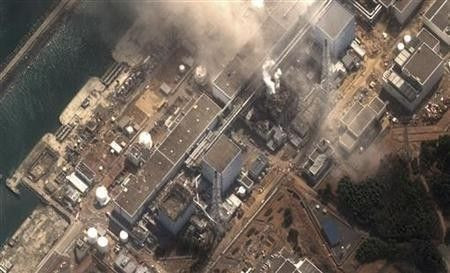Radiation level rises at No. 3 reactor at Fukushima

The level of radiation level rose at the quake-damaged Fukushima No. 1 nuclear plant on Thursday night after Japanese government fire trucks started shooting high-pressure water streams at the troubled No. 3 reactor, according to the Tokyo Electric Power Co. (TEPCO).
Specifically, radiation readings near the plant’s administration building climbed to 4,000 microsievert per hour from 3,700 just after trucks belonging to the Self-Defense Forces (SDF) tried to cool down the reactor’s overheated fuel pool. Earlier SDF helicopters dropped tons of water onto the reactor, apparently to no avail.
The radiation level around the plant’s quake-proof building where workers were standing rose to about 3,000 microsievert per hour in the morning.
Humans can be safely exposed to only 1,000 microsievert, or 1 millisievert, in one year.
Meanwhile, nuclear officials are seeking to restore electricity to the Fukushima power plant in order to revive the cooling functions that were lost earlier due to the double-whammy of earthquake and tsunami last week.
‘‘The highest priority now is to pour enough water onto the No. 3 and No. 4 reactors, especially in their spent fuel pools,’’ said Hidehiko Nishiyama, a spokesman of the government’s Nuclear and Industrial Safety Agency.
‘‘The next important thing is to recover the electric supply, and part of the work may start in the afternoon.”
Nishiyama added that electricity will probably be supplied to the plant’s No. 1 and No. 2 reactors through the use of electric power cables from outside -- a step that might help recover the reactors’ cooling systems.
SDF members also dropped huge bundles of seawater Thursday morning at the No. 3 reactor at Fukushima.
‘‘We decided to do this because we thought that today is the time limit,” said Defense Minister Toshimi Kitazawa said in Tokyo,
While Kitazawa said that he thinks the water from the helicopters reached the reactor, TEPCO, the plant’s operator, said the radiation level remained unchanged at the nuclear plant thereafter.
In the worst-case scenario, according to experts, if the pool of water in the reactor rises to about 40 Centigrade, the spent nuclear fuel rods would be exposed and perhaps melt, resulting in the release of highly lethal radioactive materials into the air and water.
The Japanese authorities currently have a team of about 180 emergency workers who are rotating in and out of the Fukushima complex to try to fix the problems at the damaged reactors. But their proximity to the reactors subjects them to radiation exposure and serious health problems.
“I don’t know any other way to say it, but this is like suicide fighters in a war,” said Keiichi Nakagawa, associate professor of the Department of Radiology at University of Tokyo Hospital, according to media reports.
© Copyright IBTimes 2024. All rights reserved.





















